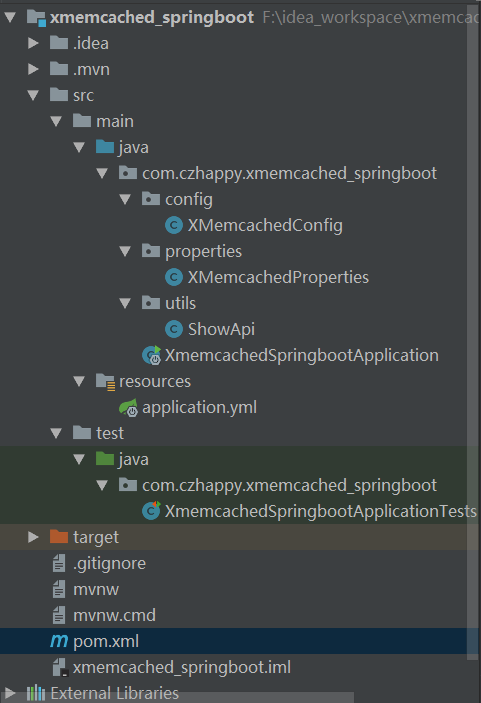创建SpringBoot项目xmemcached_springboot,添加开发需要的包名和类名,项目的目录结构如下:

添加XMemcached依赖:
<dependency> <groupId>com.googlecode.xmemcached</groupId> <artifactId>xmemcached</artifactId> <version>2.4.0</version> </dependency>
添加XMemcached相关配置到属性文件application.yml
################### memcached配置 ###################
memcached:
servers: 192.168.84.128:2222 192.168.84.128:6666
poolSize: 10
sanitizeKeys: false
openCache: true # true为启动缓存 false为标准实现
编写读取上述属性的读取类:XMemcachedProperties.java
package com.czhappy.xmemcached_springboot.properties; import org.springframework.boot.context.properties.ConfigurationProperties; import org.springframework.stereotype.Component; @Component @ConfigurationProperties(prefix = "memcached") public class XMemcachedProperties { private String servers; private int poolSize; private boolean sanitizeKeys; private boolean openCache; public boolean isOpenCache() { return openCache; } public void setOpenCache(boolean openCache) { this.openCache = openCache; } public String getServers() { return servers; } public void setServers(String servers) { this.servers = servers; } public int getPoolSize() { return poolSize; } public void setPoolSize(int poolSize) { this.poolSize = poolSize; } public boolean isSanitizeKeys() { return sanitizeKeys; } public void setSanitizeKeys(boolean sanitizeKeys) { this.sanitizeKeys = sanitizeKeys; } }
编写XMemcachedConfig.java,构建builder和client
package com.czhappy.xmemcached_springboot.config; import com.czhappy.xmemcached_springboot.properties.XMemcachedProperties; import net.rubyeye.xmemcached.MemcachedClient; import net.rubyeye.xmemcached.MemcachedClientBuilder; import net.rubyeye.xmemcached.XMemcachedClientBuilder; import net.rubyeye.xmemcached.command.BinaryCommandFactory; import net.rubyeye.xmemcached.impl.KetamaMemcachedSessionLocator; import org.springframework.beans.factory.annotation.Autowired; import org.springframework.context.annotation.Bean; import org.springframework.context.annotation.Configuration; @Configuration public class XMemcachedConfig { @Autowired private XMemcachedProperties xMemcachedProperties; // 构建builder @Bean public MemcachedClientBuilder getXMBuilder(){ MemcachedClientBuilder memcachedClientBuilder = null; try{ String servers = xMemcachedProperties.getServers(); System.out.println("servers="+servers); memcachedClientBuilder = new XMemcachedClientBuilder(servers); // 开启/关闭failure模式 memcachedClientBuilder.setFailureMode(false); memcachedClientBuilder.setSanitizeKeys(xMemcachedProperties.isSanitizeKeys()); memcachedClientBuilder.setConnectionPoolSize(xMemcachedProperties.getPoolSize()); memcachedClientBuilder.setCommandFactory(new BinaryCommandFactory()); memcachedClientBuilder.setOpTimeout(3000); memcachedClientBuilder.setSessionLocator(new KetamaMemcachedSessionLocator()); // 诸多XMemcached配置 return memcachedClientBuilder; }catch(Exception e){ e.printStackTrace(); } return null; } // client @Bean public MemcachedClient getXMClient(MemcachedClientBuilder memcachedClientBuilder){ MemcachedClient memcachedClient = null; try{ memcachedClient = memcachedClientBuilder.build(); return memcachedClient; }catch(Exception e){ e.printStackTrace(); } return null; } }
编写ShowApi.java文件,此处仅实现新增和查询方法,其他方法可参考添加
package com.czhappy.xmemcached_springboot.utils; import net.rubyeye.xmemcached.MemcachedClient; import org.springframework.beans.factory.annotation.Autowired; import org.springframework.stereotype.Service; @Service public class ShowApi { @Autowired private MemcachedClient memcachedClient; /** * 新增 * @param key * @param value */ public void showAdd(String key, String value){ try { memcachedClient.set(key, 0, value); }catch (Exception e){ e.printStackTrace(); } } public String showQuery(String key){ try { return memcachedClient.get(key); }catch (Exception e){ e.printStackTrace(); } return ""; } }
编写测试类,添加数据并打印查询的结果:
package com.czhappy.xmemcached_springboot; import com.czhappy.xmemcached_springboot.utils.ShowApi; import org.junit.Test; import org.junit.runner.RunWith; import org.springframework.beans.factory.annotation.Autowired; import org.springframework.boot.test.context.SpringBootTest; import org.springframework.test.context.junit4.SpringRunner; @RunWith(SpringRunner.class) @SpringBootTest public class XmemcachedSpringbootApplicationTests { @Autowired private ShowApi showApi; @Test public void contextLoads() { String key = "goods_name"; String value = "apple"; showApi.showAdd(key, value); System.out.println(showApi.showQuery(key)); } }
为了测试memcached集群和数据存储,我们分别启动端口为2222和6666的memcached服务端


运行测试类,可以看到后台打印出存储的结果

说明数据保存成功,我们也可以去服务端直接查询
2222端口:

6666端口:

数据具体存储在哪个memcached上我们是无法预知的,它是由客户端XMemcached内部hash算法判断实现,此处我们可以知道数据是存储成功了,通过查询最终结果能知道存在端口为6666的服务端上。